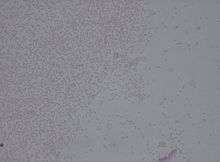Pantoea agglomerans

| Pantoea agglomerans | |
|---|---|
| Scientific classification | |
| Kingdom: | Bacteria |
| Phylum: | Proteobacteria |
| Class: | Gamma Proteobacteria |
| Order: | Enterobacteriales |
| Family: | Enterobacteriaceae |
| Genus: | Pantoea |
| Binomial name | |
| Pantoea agglomerans (Ewing and Fife 1972) Gavini et al. 1989 | |
| Type strain | |
| ATCC 27155 CCUG 539 CDC 1461-67 CFBP 3845 CIP 57.51 DSM 3493 ICPB 3435 ICMP 12534 JCM 1236 LMG 1286 NCTC 9381 | |
| Synonyms | |
|
Enterobacter agglomerans Ewing and Fife 1972 | |
Pantoea agglomerans is a Gram-negative bacterium that belongs to the family Enterobacteriaceae.
Formerly called Enterobacter agglomerans or Erwinia herbicola, it is an ubiquitous bacterium commonly isolated from plant surfaces, seeds, fruit (e.g., mandarin oranges), and animal or human feces.
Pantoea agglomerans was occasionally reported to be an opportunistic pathogen in immunocompromised patients, causing wound, blood, and urinary-tract infections. However, using the biochemical panels commonly employed in medical diagnostics it is difficult to differentiate Pantoea agglomerans from other species of the same genus or from members of related families such as Enterobacter, Klebsiella, and Serratia spp.[1] It is thus not surprising that subsequent molecular studies based on DNA sequencing have disproved the identity of several clinical isolates initially reported as Pantoea agglomerans, thus questioning the effective hazardousness of the species.[2][3] For the precise identification of Pantoea agglomerans other methods such as Multilocus sequence typing (MLST) or Whole-Cell MALDI-TOF MS are therefore recommended.[4]
Pantoea agglomerans is found in the gut of locusts, which have adapted to use the guaiacol that Pantoea agglomerans produces to initiate swarming of locusts.[5]
It is also commonly found as a symbiont in the gut of mosquitoes, where it has been genetically engineered to produce antimalaria effector molecules, reducing the prevalence of Plasmodium by up to 98% [6]
References
- ↑ Rezzonico, F.; Stockwell, V.o.; Tonolla, M.; Duffy, B.; Smits, T.h.m. (2012-04-01). "Pantoea clinical isolates cannot be accurately assigned to species based on metabolic profiling". Transplant Infectious Disease. 14 (2): 220–221. doi:10.1111/j.1399-3062.2011.00684.x. ISSN 1399-3062.
- ↑ Rezzonico, Fabio; Smits, Theo HM; Montesinos, Emilio; Frey, Jürg E.; Duffy, Brion (2009-01-01). "Genotypic comparison of Pantoea agglomerans plant and clinical strains". BMC Microbiology. 9: 204. doi:10.1186/1471-2180-9-204. ISSN 1471-2180. PMC 2764716
 . PMID 19772624.
. PMID 19772624. - ↑ Delétoile, Alexis; Decré, Dominique; Courant, Stéphanie; Passet, Virginie; Audo, Jennifer; Grimont, Patrick; Arlet, Guillaume; Brisse, Sylvain (2009-02-01). "Phylogeny and Identification of Pantoea Species and Typing of Pantoea agglomerans Strains by Multilocus Gene Sequencing". Journal of Clinical Microbiology. 47 (2): 300–310. doi:10.1128/JCM.01916-08. ISSN 0095-1137. PMC 2643697
 . PMID 19052179.
. PMID 19052179. - ↑ Rezzonico, Fabio; Vogel, Guido; Duffy, Brion; Tonolla, Mauro (2010-07-01). "Application of Whole-Cell Matrix-Assisted Laser Desorption Ionization-Time of Flight Mass Spectrometry for Rapid Identification and Clustering Analysis of Pantoea Species". Applied and Environmental Microbiology. 76 (13): 4497–4509. doi:10.1128/AEM.03112-09. ISSN 0099-2240. PMC 2897409
 . PMID 20453125.
. PMID 20453125. - ↑ Nature, Pheromones: Exploitation of gut bacteria in the locust
- ↑ Wang, Sibao, et al. "Fighting malaria with engineered symbiotic bacteria from vector mosquitoes." Proceedings of the National Academy of Sciences 109.31 (2012): 12734-12739.